Strategic Information Systems for Amc Improvements and Advancements
VerifiedAdded on 2020/05/16
|10
|2946
|57
AI Summary
The report examines the role of strategic information systems in business organizations, particularly for Amcor. It discusses how these systems can be utilized to enhance operational efficiencies, improve product and service delivery, and achieve set targets. The analysis highlights key areas such as Enterprise Resource Planning (ERP) adoption, readiness, performance factors post-implementation, and governance aspects like internal control and management involvement. By adopting strategic IS practices, Amcor can ensure streamlined processes and better decision-making capabilities, ultimately contributing to its competitive edge in the market.

Running Header: Strategic Information System
Strategic Information System
Authors ID:
Authors Name:
Strategic Information System
Authors ID:
Authors Name:
Paraphrase This Document
Need a fresh take? Get an instant paraphrase of this document with our AI Paraphraser
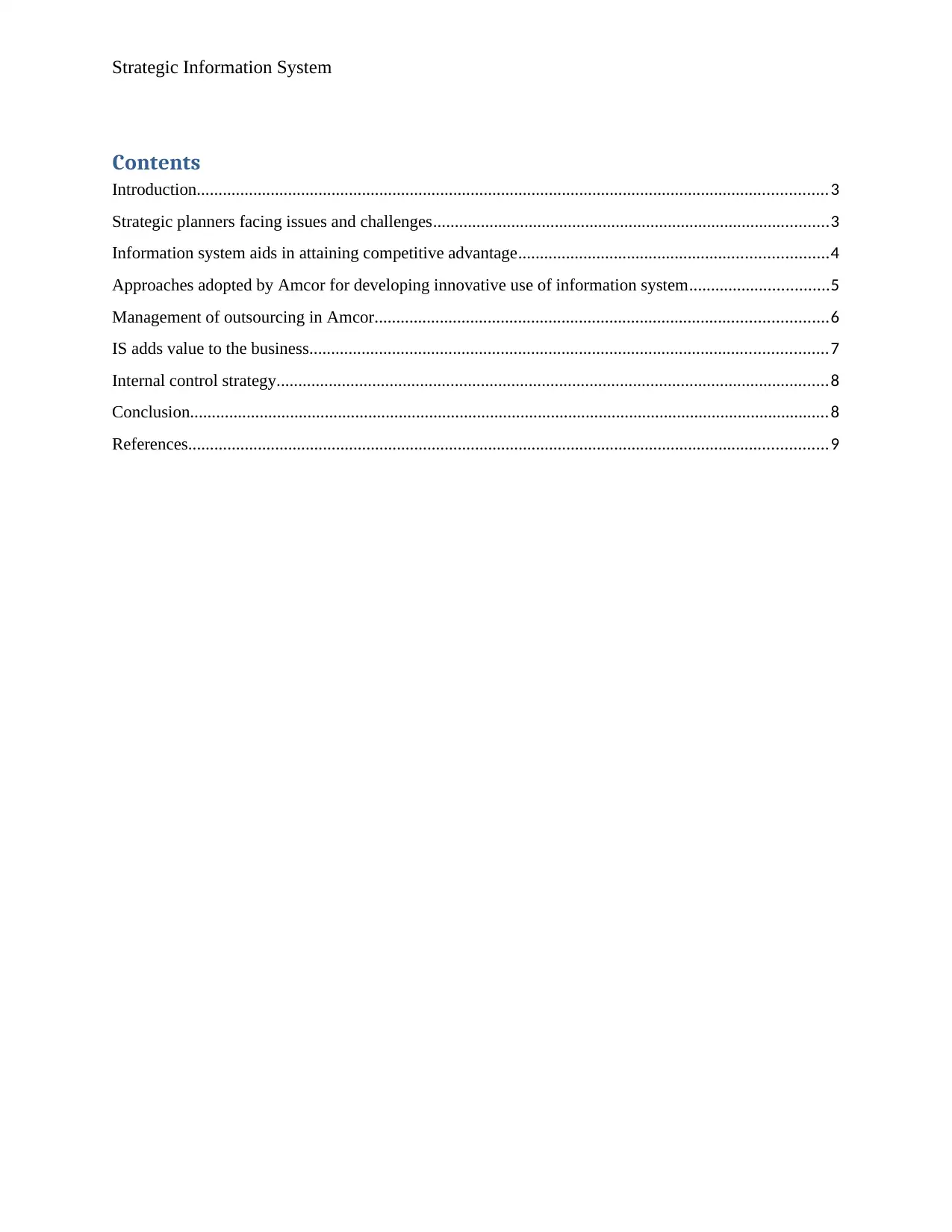
Strategic Information System
Contents
Introduction.................................................................................................................................................3
Strategic planners facing issues and challenges...........................................................................................3
Information system aids in attaining competitive advantage.......................................................................4
Approaches adopted by Amcor for developing innovative use of information system................................5
Management of outsourcing in Amcor........................................................................................................6
IS adds value to the business.......................................................................................................................7
Internal control strategy...............................................................................................................................8
Conclusion...................................................................................................................................................8
References...................................................................................................................................................9
Contents
Introduction.................................................................................................................................................3
Strategic planners facing issues and challenges...........................................................................................3
Information system aids in attaining competitive advantage.......................................................................4
Approaches adopted by Amcor for developing innovative use of information system................................5
Management of outsourcing in Amcor........................................................................................................6
IS adds value to the business.......................................................................................................................7
Internal control strategy...............................................................................................................................8
Conclusion...................................................................................................................................................8
References...................................................................................................................................................9
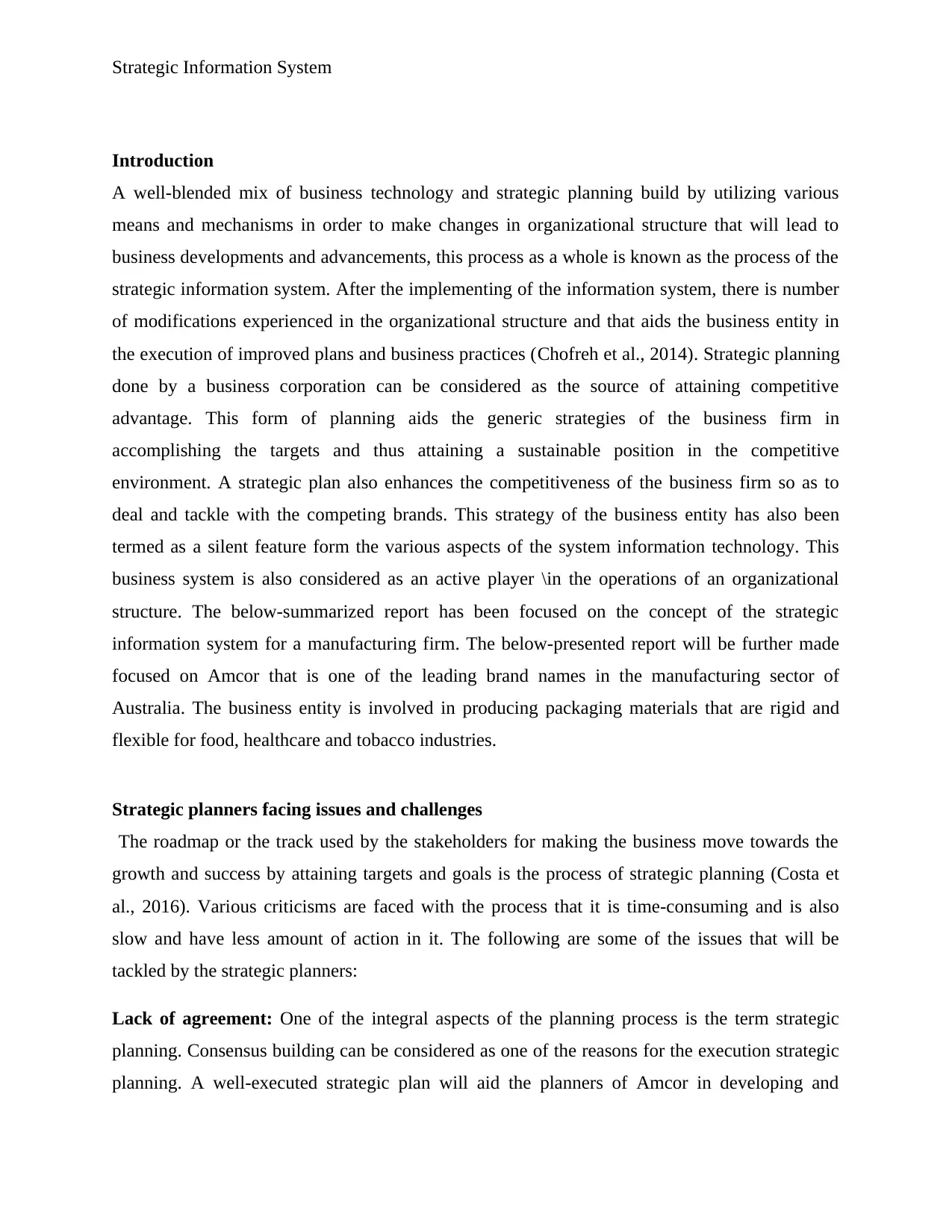
Strategic Information System
Introduction
A well-blended mix of business technology and strategic planning build by utilizing various
means and mechanisms in order to make changes in organizational structure that will lead to
business developments and advancements, this process as a whole is known as the process of the
strategic information system. After the implementing of the information system, there is number
of modifications experienced in the organizational structure and that aids the business entity in
the execution of improved plans and business practices (Chofreh et al., 2014). Strategic planning
done by a business corporation can be considered as the source of attaining competitive
advantage. This form of planning aids the generic strategies of the business firm in
accomplishing the targets and thus attaining a sustainable position in the competitive
environment. A strategic plan also enhances the competitiveness of the business firm so as to
deal and tackle with the competing brands. This strategy of the business entity has also been
termed as a silent feature form the various aspects of the system information technology. This
business system is also considered as an active player \in the operations of an organizational
structure. The below-summarized report has been focused on the concept of the strategic
information system for a manufacturing firm. The below-presented report will be further made
focused on Amcor that is one of the leading brand names in the manufacturing sector of
Australia. The business entity is involved in producing packaging materials that are rigid and
flexible for food, healthcare and tobacco industries.
Strategic planners facing issues and challenges
The roadmap or the track used by the stakeholders for making the business move towards the
growth and success by attaining targets and goals is the process of strategic planning (Costa et
al., 2016). Various criticisms are faced with the process that it is time-consuming and is also
slow and have less amount of action in it. The following are some of the issues that will be
tackled by the strategic planners:
Lack of agreement: One of the integral aspects of the planning process is the term strategic
planning. Consensus building can be considered as one of the reasons for the execution strategic
planning. A well-executed strategic plan will aid the planners of Amcor in developing and
Introduction
A well-blended mix of business technology and strategic planning build by utilizing various
means and mechanisms in order to make changes in organizational structure that will lead to
business developments and advancements, this process as a whole is known as the process of the
strategic information system. After the implementing of the information system, there is number
of modifications experienced in the organizational structure and that aids the business entity in
the execution of improved plans and business practices (Chofreh et al., 2014). Strategic planning
done by a business corporation can be considered as the source of attaining competitive
advantage. This form of planning aids the generic strategies of the business firm in
accomplishing the targets and thus attaining a sustainable position in the competitive
environment. A strategic plan also enhances the competitiveness of the business firm so as to
deal and tackle with the competing brands. This strategy of the business entity has also been
termed as a silent feature form the various aspects of the system information technology. This
business system is also considered as an active player \in the operations of an organizational
structure. The below-summarized report has been focused on the concept of the strategic
information system for a manufacturing firm. The below-presented report will be further made
focused on Amcor that is one of the leading brand names in the manufacturing sector of
Australia. The business entity is involved in producing packaging materials that are rigid and
flexible for food, healthcare and tobacco industries.
Strategic planners facing issues and challenges
The roadmap or the track used by the stakeholders for making the business move towards the
growth and success by attaining targets and goals is the process of strategic planning (Costa et
al., 2016). Various criticisms are faced with the process that it is time-consuming and is also
slow and have less amount of action in it. The following are some of the issues that will be
tackled by the strategic planners:
Lack of agreement: One of the integral aspects of the planning process is the term strategic
planning. Consensus building can be considered as one of the reasons for the execution strategic
planning. A well-executed strategic plan will aid the planners of Amcor in developing and
⊘ This is a preview!⊘
Do you want full access?
Subscribe today to unlock all pages.

Trusted by 1+ million students worldwide
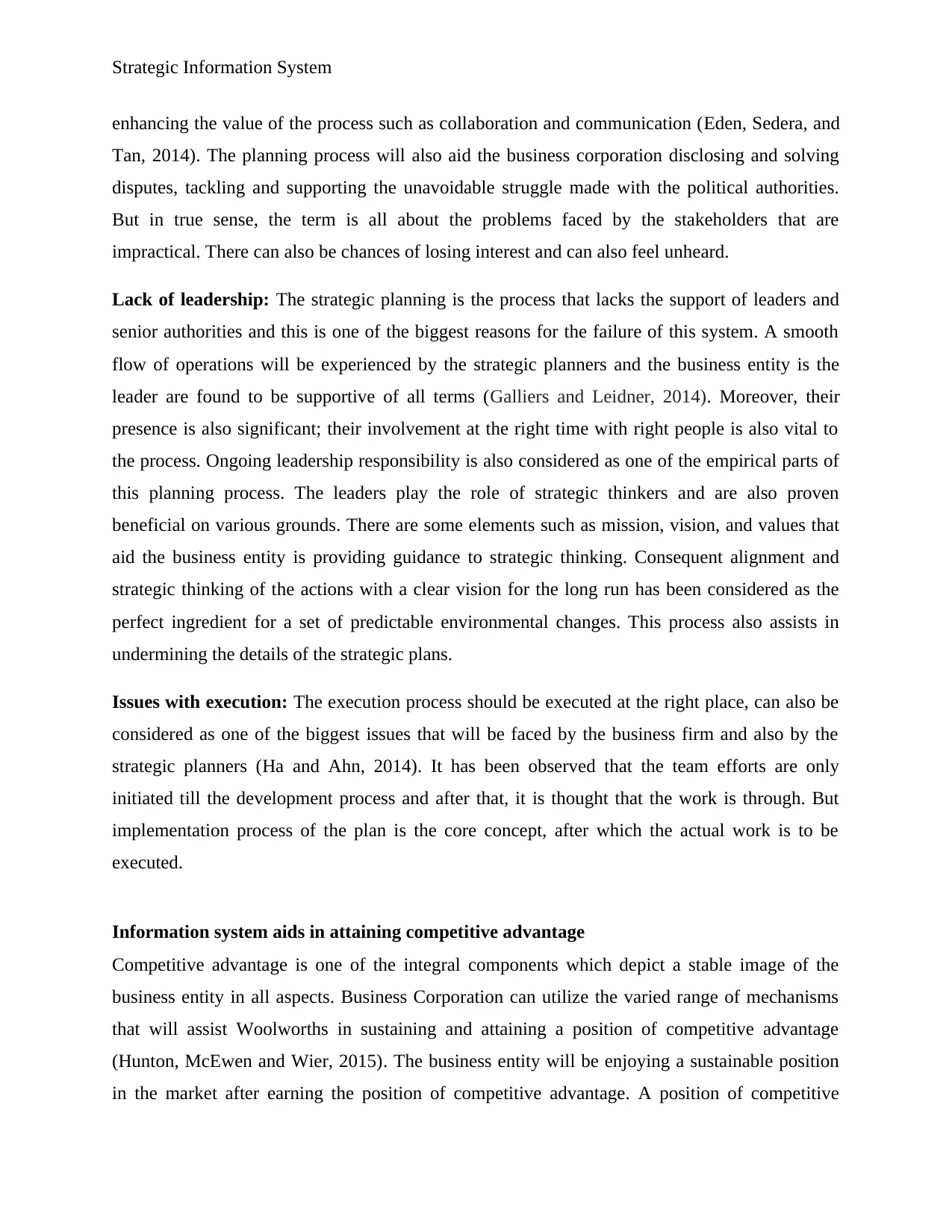
Strategic Information System
enhancing the value of the process such as collaboration and communication (Eden, Sedera, and
Tan, 2014). The planning process will also aid the business corporation disclosing and solving
disputes, tackling and supporting the unavoidable struggle made with the political authorities.
But in true sense, the term is all about the problems faced by the stakeholders that are
impractical. There can also be chances of losing interest and can also feel unheard.
Lack of leadership: The strategic planning is the process that lacks the support of leaders and
senior authorities and this is one of the biggest reasons for the failure of this system. A smooth
flow of operations will be experienced by the strategic planners and the business entity is the
leader are found to be supportive of all terms (Galliers and Leidner, 2014). Moreover, their
presence is also significant; their involvement at the right time with right people is also vital to
the process. Ongoing leadership responsibility is also considered as one of the empirical parts of
this planning process. The leaders play the role of strategic thinkers and are also proven
beneficial on various grounds. There are some elements such as mission, vision, and values that
aid the business entity is providing guidance to strategic thinking. Consequent alignment and
strategic thinking of the actions with a clear vision for the long run has been considered as the
perfect ingredient for a set of predictable environmental changes. This process also assists in
undermining the details of the strategic plans.
Issues with execution: The execution process should be executed at the right place, can also be
considered as one of the biggest issues that will be faced by the business firm and also by the
strategic planners (Ha and Ahn, 2014). It has been observed that the team efforts are only
initiated till the development process and after that, it is thought that the work is through. But
implementation process of the plan is the core concept, after which the actual work is to be
executed.
Information system aids in attaining competitive advantage
Competitive advantage is one of the integral components which depict a stable image of the
business entity in all aspects. Business Corporation can utilize the varied range of mechanisms
that will assist Woolworths in sustaining and attaining a position of competitive advantage
(Hunton, McEwen and Wier, 2015). The business entity will be enjoying a sustainable position
in the market after earning the position of competitive advantage. A position of competitive
enhancing the value of the process such as collaboration and communication (Eden, Sedera, and
Tan, 2014). The planning process will also aid the business corporation disclosing and solving
disputes, tackling and supporting the unavoidable struggle made with the political authorities.
But in true sense, the term is all about the problems faced by the stakeholders that are
impractical. There can also be chances of losing interest and can also feel unheard.
Lack of leadership: The strategic planning is the process that lacks the support of leaders and
senior authorities and this is one of the biggest reasons for the failure of this system. A smooth
flow of operations will be experienced by the strategic planners and the business entity is the
leader are found to be supportive of all terms (Galliers and Leidner, 2014). Moreover, their
presence is also significant; their involvement at the right time with right people is also vital to
the process. Ongoing leadership responsibility is also considered as one of the empirical parts of
this planning process. The leaders play the role of strategic thinkers and are also proven
beneficial on various grounds. There are some elements such as mission, vision, and values that
aid the business entity is providing guidance to strategic thinking. Consequent alignment and
strategic thinking of the actions with a clear vision for the long run has been considered as the
perfect ingredient for a set of predictable environmental changes. This process also assists in
undermining the details of the strategic plans.
Issues with execution: The execution process should be executed at the right place, can also be
considered as one of the biggest issues that will be faced by the business firm and also by the
strategic planners (Ha and Ahn, 2014). It has been observed that the team efforts are only
initiated till the development process and after that, it is thought that the work is through. But
implementation process of the plan is the core concept, after which the actual work is to be
executed.
Information system aids in attaining competitive advantage
Competitive advantage is one of the integral components which depict a stable image of the
business entity in all aspects. Business Corporation can utilize the varied range of mechanisms
that will assist Woolworths in sustaining and attaining a position of competitive advantage
(Hunton, McEwen and Wier, 2015). The business entity will be enjoying a sustainable position
in the market after earning the position of competitive advantage. A position of competitive
Paraphrase This Document
Need a fresh take? Get an instant paraphrase of this document with our AI Paraphraser
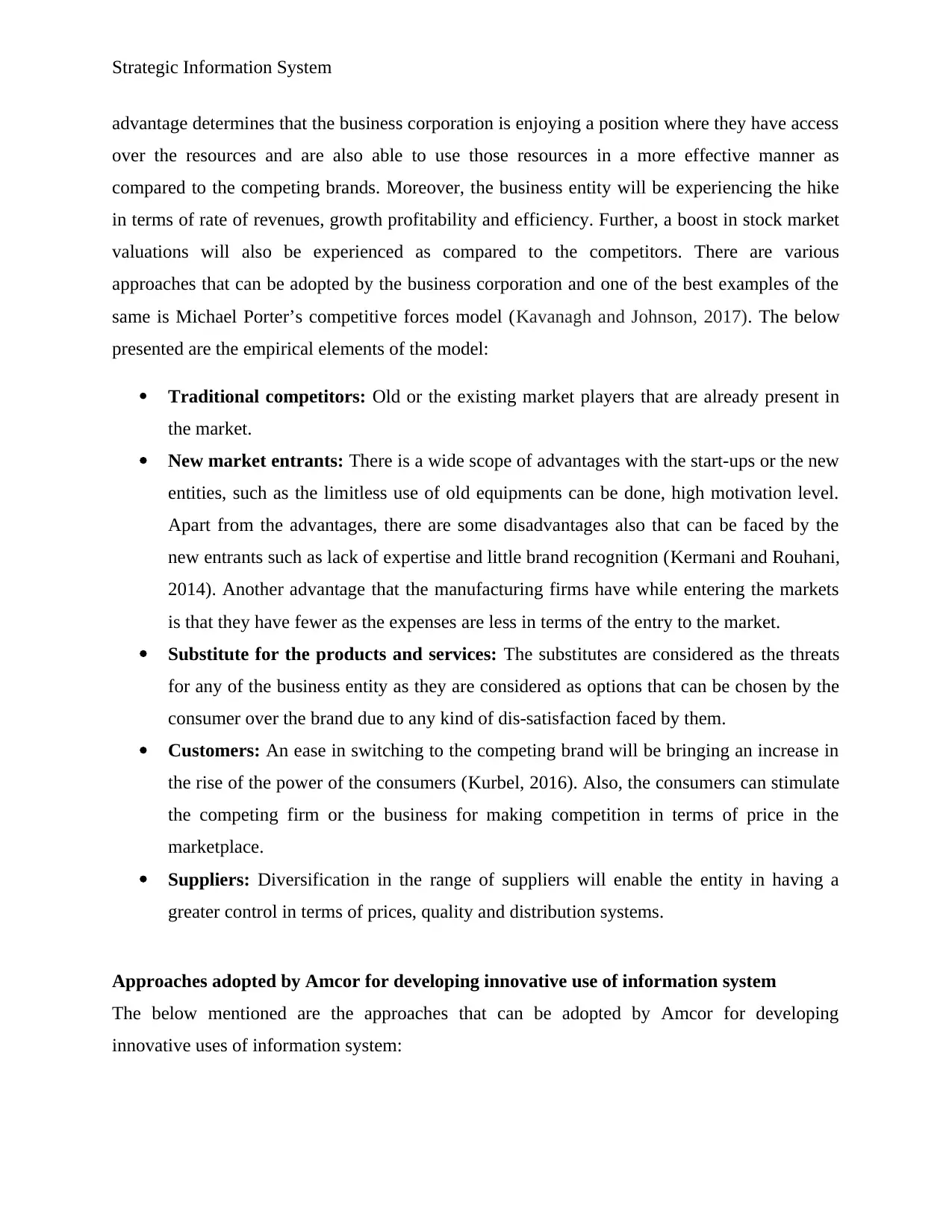
Strategic Information System
advantage determines that the business corporation is enjoying a position where they have access
over the resources and are also able to use those resources in a more effective manner as
compared to the competing brands. Moreover, the business entity will be experiencing the hike
in terms of rate of revenues, growth profitability and efficiency. Further, a boost in stock market
valuations will also be experienced as compared to the competitors. There are various
approaches that can be adopted by the business corporation and one of the best examples of the
same is Michael Porter’s competitive forces model (Kavanagh and Johnson, 2017). The below
presented are the empirical elements of the model:
Traditional competitors: Old or the existing market players that are already present in
the market.
New market entrants: There is a wide scope of advantages with the start-ups or the new
entities, such as the limitless use of old equipments can be done, high motivation level.
Apart from the advantages, there are some disadvantages also that can be faced by the
new entrants such as lack of expertise and little brand recognition (Kermani and Rouhani,
2014). Another advantage that the manufacturing firms have while entering the markets
is that they have fewer as the expenses are less in terms of the entry to the market.
Substitute for the products and services: The substitutes are considered as the threats
for any of the business entity as they are considered as options that can be chosen by the
consumer over the brand due to any kind of dis-satisfaction faced by them.
Customers: An ease in switching to the competing brand will be bringing an increase in
the rise of the power of the consumers (Kurbel, 2016). Also, the consumers can stimulate
the competing firm or the business for making competition in terms of price in the
marketplace.
Suppliers: Diversification in the range of suppliers will enable the entity in having a
greater control in terms of prices, quality and distribution systems.
Approaches adopted by Amcor for developing innovative use of information system
The below mentioned are the approaches that can be adopted by Amcor for developing
innovative uses of information system:
advantage determines that the business corporation is enjoying a position where they have access
over the resources and are also able to use those resources in a more effective manner as
compared to the competing brands. Moreover, the business entity will be experiencing the hike
in terms of rate of revenues, growth profitability and efficiency. Further, a boost in stock market
valuations will also be experienced as compared to the competitors. There are various
approaches that can be adopted by the business corporation and one of the best examples of the
same is Michael Porter’s competitive forces model (Kavanagh and Johnson, 2017). The below
presented are the empirical elements of the model:
Traditional competitors: Old or the existing market players that are already present in
the market.
New market entrants: There is a wide scope of advantages with the start-ups or the new
entities, such as the limitless use of old equipments can be done, high motivation level.
Apart from the advantages, there are some disadvantages also that can be faced by the
new entrants such as lack of expertise and little brand recognition (Kermani and Rouhani,
2014). Another advantage that the manufacturing firms have while entering the markets
is that they have fewer as the expenses are less in terms of the entry to the market.
Substitute for the products and services: The substitutes are considered as the threats
for any of the business entity as they are considered as options that can be chosen by the
consumer over the brand due to any kind of dis-satisfaction faced by them.
Customers: An ease in switching to the competing brand will be bringing an increase in
the rise of the power of the consumers (Kurbel, 2016). Also, the consumers can stimulate
the competing firm or the business for making competition in terms of price in the
marketplace.
Suppliers: Diversification in the range of suppliers will enable the entity in having a
greater control in terms of prices, quality and distribution systems.
Approaches adopted by Amcor for developing innovative use of information system
The below mentioned are the approaches that can be adopted by Amcor for developing
innovative uses of information system:
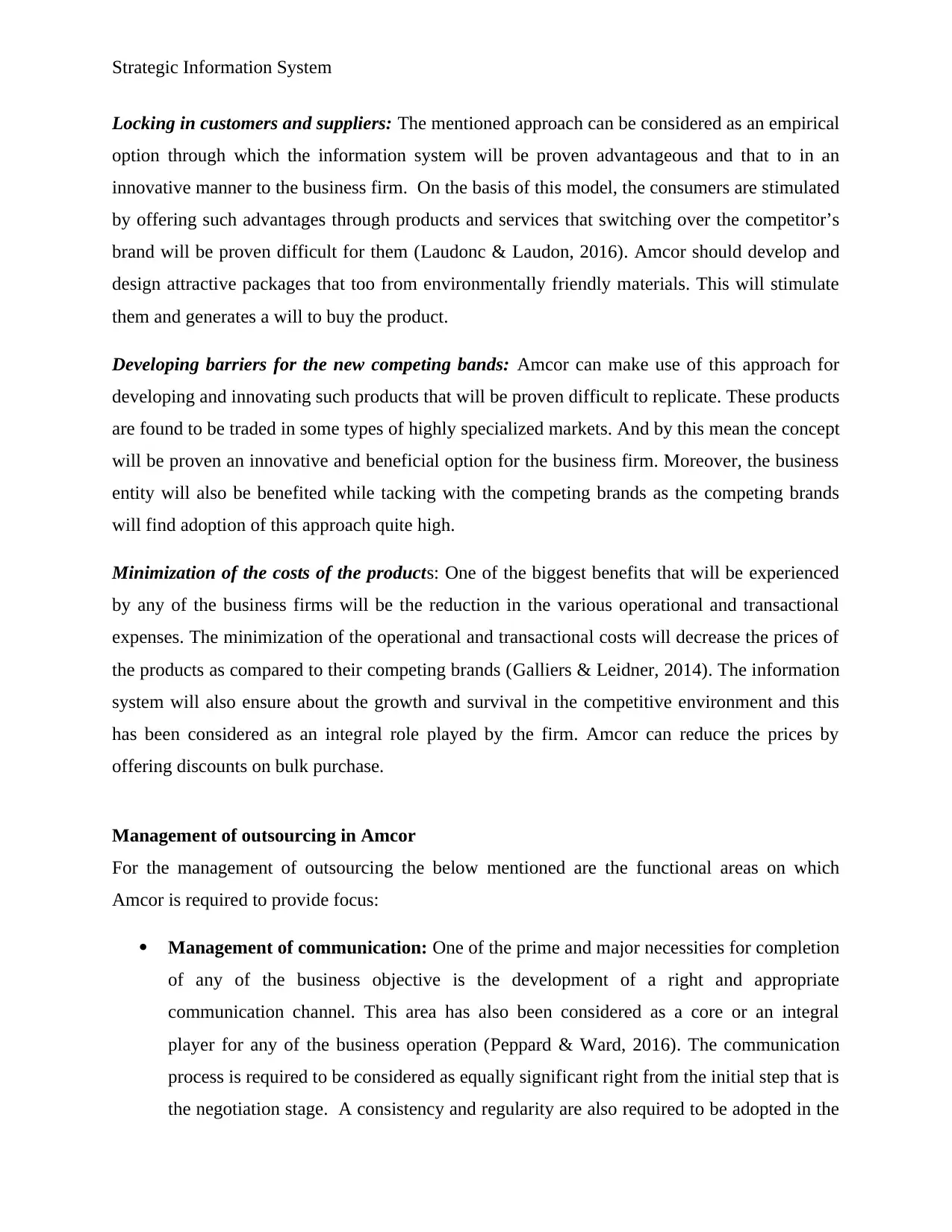
Strategic Information System
Locking in customers and suppliers: The mentioned approach can be considered as an empirical
option through which the information system will be proven advantageous and that to in an
innovative manner to the business firm. On the basis of this model, the consumers are stimulated
by offering such advantages through products and services that switching over the competitor’s
brand will be proven difficult for them (Laudonc & Laudon, 2016). Amcor should develop and
design attractive packages that too from environmentally friendly materials. This will stimulate
them and generates a will to buy the product.
Developing barriers for the new competing bands: Amcor can make use of this approach for
developing and innovating such products that will be proven difficult to replicate. These products
are found to be traded in some types of highly specialized markets. And by this mean the concept
will be proven an innovative and beneficial option for the business firm. Moreover, the business
entity will also be benefited while tacking with the competing brands as the competing brands
will find adoption of this approach quite high.
Minimization of the costs of the products: One of the biggest benefits that will be experienced
by any of the business firms will be the reduction in the various operational and transactional
expenses. The minimization of the operational and transactional costs will decrease the prices of
the products as compared to their competing brands (Galliers & Leidner, 2014). The information
system will also ensure about the growth and survival in the competitive environment and this
has been considered as an integral role played by the firm. Amcor can reduce the prices by
offering discounts on bulk purchase.
Management of outsourcing in Amcor
For the management of outsourcing the below mentioned are the functional areas on which
Amcor is required to provide focus:
Management of communication: One of the prime and major necessities for completion
of any of the business objective is the development of a right and appropriate
communication channel. This area has also been considered as a core or an integral
player for any of the business operation (Peppard & Ward, 2016). The communication
process is required to be considered as equally significant right from the initial step that is
the negotiation stage. A consistency and regularity are also required to be adopted in the
Locking in customers and suppliers: The mentioned approach can be considered as an empirical
option through which the information system will be proven advantageous and that to in an
innovative manner to the business firm. On the basis of this model, the consumers are stimulated
by offering such advantages through products and services that switching over the competitor’s
brand will be proven difficult for them (Laudonc & Laudon, 2016). Amcor should develop and
design attractive packages that too from environmentally friendly materials. This will stimulate
them and generates a will to buy the product.
Developing barriers for the new competing bands: Amcor can make use of this approach for
developing and innovating such products that will be proven difficult to replicate. These products
are found to be traded in some types of highly specialized markets. And by this mean the concept
will be proven an innovative and beneficial option for the business firm. Moreover, the business
entity will also be benefited while tacking with the competing brands as the competing brands
will find adoption of this approach quite high.
Minimization of the costs of the products: One of the biggest benefits that will be experienced
by any of the business firms will be the reduction in the various operational and transactional
expenses. The minimization of the operational and transactional costs will decrease the prices of
the products as compared to their competing brands (Galliers & Leidner, 2014). The information
system will also ensure about the growth and survival in the competitive environment and this
has been considered as an integral role played by the firm. Amcor can reduce the prices by
offering discounts on bulk purchase.
Management of outsourcing in Amcor
For the management of outsourcing the below mentioned are the functional areas on which
Amcor is required to provide focus:
Management of communication: One of the prime and major necessities for completion
of any of the business objective is the development of a right and appropriate
communication channel. This area has also been considered as a core or an integral
player for any of the business operation (Peppard & Ward, 2016). The communication
process is required to be considered as equally significant right from the initial step that is
the negotiation stage. A consistency and regularity are also required to be adopted in the
⊘ This is a preview!⊘
Do you want full access?
Subscribe today to unlock all pages.

Trusted by 1+ million students worldwide

Strategic Information System
communication system. Regularity will enhance the quality of the relations between the
client and the service provider and that will enable the business entity to develop better
and improved products and services.
Cost management: Choosing to outsource as a strategic option is due to the cost. This
has been considered as the biggest reason for which the entity adopted outsourcing. A
considerable amount of profit will be earned by making adoption of outsourcing
(Cassidy, 2016). And hence the approach will play a dual significant role as it aids both
the parties in analyzing the scope and expenses of the outsourced projects before they are
signed the contract.
IS adds value to the business
Being a market leader in the concerned industry is the biggest try for any of the business entity
and also there are some elements that are held liable for delaying the goals and achievements.
And hence there will be a need for Amcor for the adoption of some strategies so as to tackle
these situations and further which will lead the firm towards competitive advantage (López & La
Paz, 2017). The below mentioned are the fundamentals through which it will be defined that the
IS adds value to the business:
Decision-making process is assisted: The adequacy of the strategic plans has been considered
as the vital element on which the success and growth of the organization are made relied. The
strategic plans are formulated by management team by using the information system which
assists the entity in the decisions regarding the success and development of the firm. An
information system can also be used for evaluating the data received from all the sources. Data
from external sources such as references are included under this,
Information storage analysis: The data are not managed manually by the business entities at the
initial stages that are no registers and hard copies are maintained. Sophisticated and
comprehensive databases can be utilized by Amcor by making use of information system. These
databases can comprise of confidential information about the organization (Hill, Jones &
Schilling, 2014). Moreover, analysis, storing and updating of the data is also done by the
information systems and which can be father utilized by the entity for solving the issues.
communication system. Regularity will enhance the quality of the relations between the
client and the service provider and that will enable the business entity to develop better
and improved products and services.
Cost management: Choosing to outsource as a strategic option is due to the cost. This
has been considered as the biggest reason for which the entity adopted outsourcing. A
considerable amount of profit will be earned by making adoption of outsourcing
(Cassidy, 2016). And hence the approach will play a dual significant role as it aids both
the parties in analyzing the scope and expenses of the outsourced projects before they are
signed the contract.
IS adds value to the business
Being a market leader in the concerned industry is the biggest try for any of the business entity
and also there are some elements that are held liable for delaying the goals and achievements.
And hence there will be a need for Amcor for the adoption of some strategies so as to tackle
these situations and further which will lead the firm towards competitive advantage (López & La
Paz, 2017). The below mentioned are the fundamentals through which it will be defined that the
IS adds value to the business:
Decision-making process is assisted: The adequacy of the strategic plans has been considered
as the vital element on which the success and growth of the organization are made relied. The
strategic plans are formulated by management team by using the information system which
assists the entity in the decisions regarding the success and development of the firm. An
information system can also be used for evaluating the data received from all the sources. Data
from external sources such as references are included under this,
Information storage analysis: The data are not managed manually by the business entities at the
initial stages that are no registers and hard copies are maintained. Sophisticated and
comprehensive databases can be utilized by Amcor by making use of information system. These
databases can comprise of confidential information about the organization (Hill, Jones &
Schilling, 2014). Moreover, analysis, storing and updating of the data is also done by the
information systems and which can be father utilized by the entity for solving the issues.
Paraphrase This Document
Need a fresh take? Get an instant paraphrase of this document with our AI Paraphraser
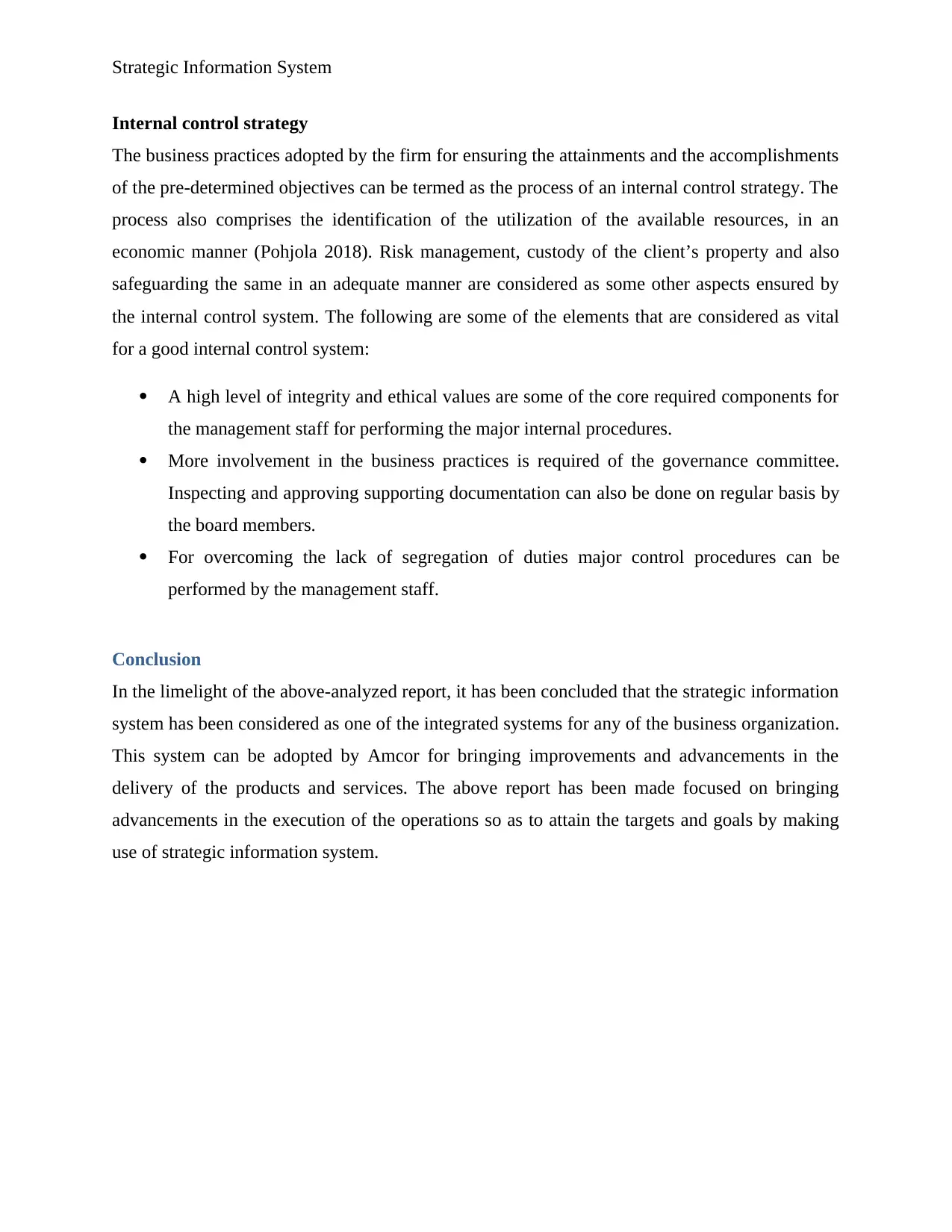
Strategic Information System
Internal control strategy
The business practices adopted by the firm for ensuring the attainments and the accomplishments
of the pre-determined objectives can be termed as the process of an internal control strategy. The
process also comprises the identification of the utilization of the available resources, in an
economic manner (Pohjola 2018). Risk management, custody of the client’s property and also
safeguarding the same in an adequate manner are considered as some other aspects ensured by
the internal control system. The following are some of the elements that are considered as vital
for a good internal control system:
A high level of integrity and ethical values are some of the core required components for
the management staff for performing the major internal procedures.
More involvement in the business practices is required of the governance committee.
Inspecting and approving supporting documentation can also be done on regular basis by
the board members.
For overcoming the lack of segregation of duties major control procedures can be
performed by the management staff.
Conclusion
In the limelight of the above-analyzed report, it has been concluded that the strategic information
system has been considered as one of the integrated systems for any of the business organization.
This system can be adopted by Amcor for bringing improvements and advancements in the
delivery of the products and services. The above report has been made focused on bringing
advancements in the execution of the operations so as to attain the targets and goals by making
use of strategic information system.
Internal control strategy
The business practices adopted by the firm for ensuring the attainments and the accomplishments
of the pre-determined objectives can be termed as the process of an internal control strategy. The
process also comprises the identification of the utilization of the available resources, in an
economic manner (Pohjola 2018). Risk management, custody of the client’s property and also
safeguarding the same in an adequate manner are considered as some other aspects ensured by
the internal control system. The following are some of the elements that are considered as vital
for a good internal control system:
A high level of integrity and ethical values are some of the core required components for
the management staff for performing the major internal procedures.
More involvement in the business practices is required of the governance committee.
Inspecting and approving supporting documentation can also be done on regular basis by
the board members.
For overcoming the lack of segregation of duties major control procedures can be
performed by the management staff.
Conclusion
In the limelight of the above-analyzed report, it has been concluded that the strategic information
system has been considered as one of the integrated systems for any of the business organization.
This system can be adopted by Amcor for bringing improvements and advancements in the
delivery of the products and services. The above report has been made focused on bringing
advancements in the execution of the operations so as to attain the targets and goals by making
use of strategic information system.
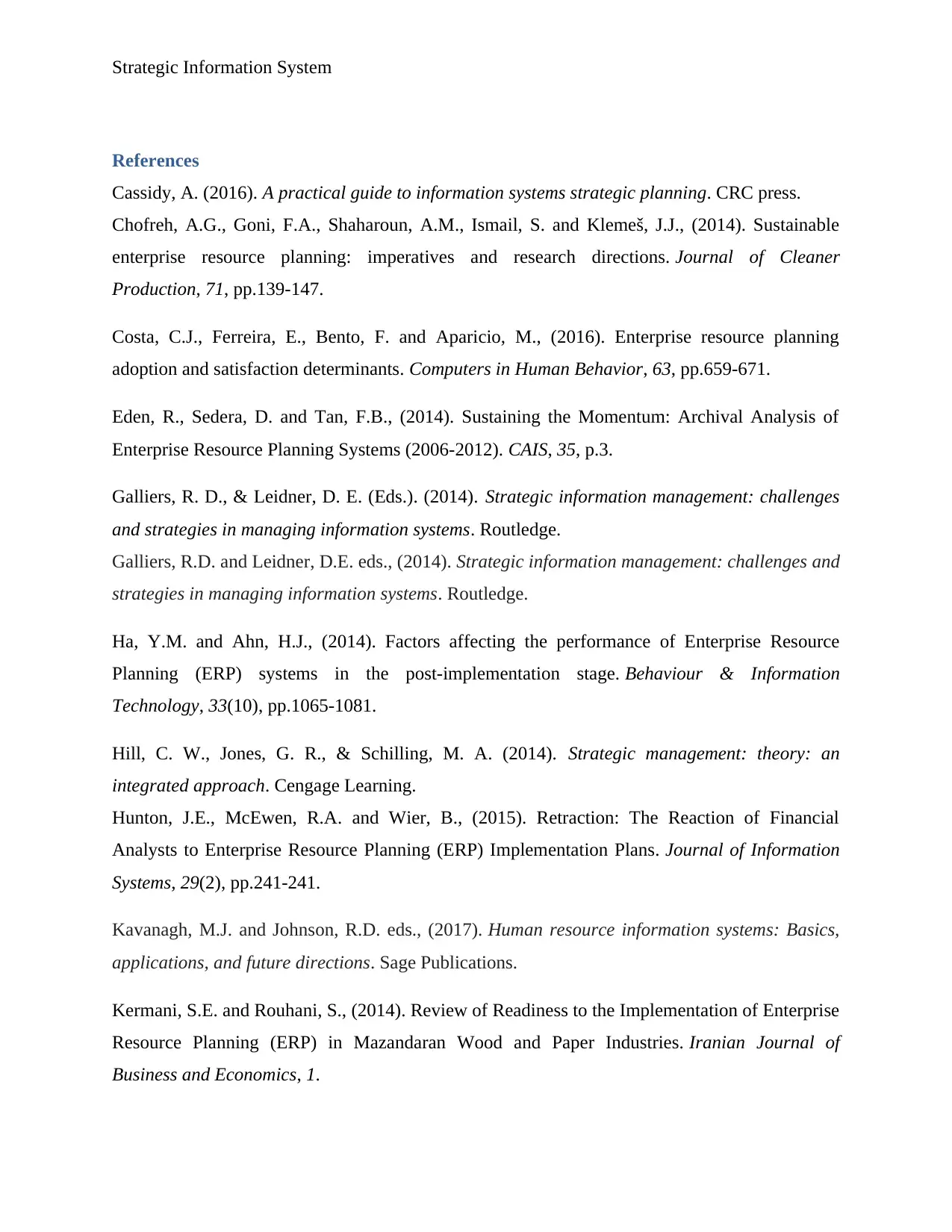
Strategic Information System
References
Cassidy, A. (2016). A practical guide to information systems strategic planning. CRC press.
Chofreh, A.G., Goni, F.A., Shaharoun, A.M., Ismail, S. and Klemeš, J.J., (2014). Sustainable
enterprise resource planning: imperatives and research directions. Journal of Cleaner
Production, 71, pp.139-147.
Costa, C.J., Ferreira, E., Bento, F. and Aparicio, M., (2016). Enterprise resource planning
adoption and satisfaction determinants. Computers in Human Behavior, 63, pp.659-671.
Eden, R., Sedera, D. and Tan, F.B., (2014). Sustaining the Momentum: Archival Analysis of
Enterprise Resource Planning Systems (2006-2012). CAIS, 35, p.3.
Galliers, R. D., & Leidner, D. E. (Eds.). (2014). Strategic information management: challenges
and strategies in managing information systems. Routledge.
Galliers, R.D. and Leidner, D.E. eds., (2014). Strategic information management: challenges and
strategies in managing information systems. Routledge.
Ha, Y.M. and Ahn, H.J., (2014). Factors affecting the performance of Enterprise Resource
Planning (ERP) systems in the post-implementation stage. Behaviour & Information
Technology, 33(10), pp.1065-1081.
Hill, C. W., Jones, G. R., & Schilling, M. A. (2014). Strategic management: theory: an
integrated approach. Cengage Learning.
Hunton, J.E., McEwen, R.A. and Wier, B., (2015). Retraction: The Reaction of Financial
Analysts to Enterprise Resource Planning (ERP) Implementation Plans. Journal of Information
Systems, 29(2), pp.241-241.
Kavanagh, M.J. and Johnson, R.D. eds., (2017). Human resource information systems: Basics,
applications, and future directions. Sage Publications.
Kermani, S.E. and Rouhani, S., (2014). Review of Readiness to the Implementation of Enterprise
Resource Planning (ERP) in Mazandaran Wood and Paper Industries. Iranian Journal of
Business and Economics, 1.
References
Cassidy, A. (2016). A practical guide to information systems strategic planning. CRC press.
Chofreh, A.G., Goni, F.A., Shaharoun, A.M., Ismail, S. and Klemeš, J.J., (2014). Sustainable
enterprise resource planning: imperatives and research directions. Journal of Cleaner
Production, 71, pp.139-147.
Costa, C.J., Ferreira, E., Bento, F. and Aparicio, M., (2016). Enterprise resource planning
adoption and satisfaction determinants. Computers in Human Behavior, 63, pp.659-671.
Eden, R., Sedera, D. and Tan, F.B., (2014). Sustaining the Momentum: Archival Analysis of
Enterprise Resource Planning Systems (2006-2012). CAIS, 35, p.3.
Galliers, R. D., & Leidner, D. E. (Eds.). (2014). Strategic information management: challenges
and strategies in managing information systems. Routledge.
Galliers, R.D. and Leidner, D.E. eds., (2014). Strategic information management: challenges and
strategies in managing information systems. Routledge.
Ha, Y.M. and Ahn, H.J., (2014). Factors affecting the performance of Enterprise Resource
Planning (ERP) systems in the post-implementation stage. Behaviour & Information
Technology, 33(10), pp.1065-1081.
Hill, C. W., Jones, G. R., & Schilling, M. A. (2014). Strategic management: theory: an
integrated approach. Cengage Learning.
Hunton, J.E., McEwen, R.A. and Wier, B., (2015). Retraction: The Reaction of Financial
Analysts to Enterprise Resource Planning (ERP) Implementation Plans. Journal of Information
Systems, 29(2), pp.241-241.
Kavanagh, M.J. and Johnson, R.D. eds., (2017). Human resource information systems: Basics,
applications, and future directions. Sage Publications.
Kermani, S.E. and Rouhani, S., (2014). Review of Readiness to the Implementation of Enterprise
Resource Planning (ERP) in Mazandaran Wood and Paper Industries. Iranian Journal of
Business and Economics, 1.
⊘ This is a preview!⊘
Do you want full access?
Subscribe today to unlock all pages.

Trusted by 1+ million students worldwide

Strategic Information System
Kurbel, K.E., (2016). Enterprise Resource Planning And Supply Chain Management. Springer-
Verlag Berlin An.
Laudon, K. C., & Laudon, J. P. (2016). Management information system. Pearson Education
India.
López, E., & La Paz, A. (2017). Ontology of Strategic Information Systems Planning. In
International Conference on Information Resources Management, CONF-IRM 2017
Proceedings, Santiago de Chile. http://aisel. aisnet. org/confirm2017/22.
Peppard, J., & Ward, J. (2016). The strategic management of information systems: Building a
digital strategy. John Wiley & Sons.
Pohjola, (2018). Internal control, Assessed on 24th January 2018,
https://www.pohjola.fi/pohjola/investor-relations/corporate-governance/internal-and-external-
control/internal-control?id=336451&srcpl=1&kielikoodi=en.
Kurbel, K.E., (2016). Enterprise Resource Planning And Supply Chain Management. Springer-
Verlag Berlin An.
Laudon, K. C., & Laudon, J. P. (2016). Management information system. Pearson Education
India.
López, E., & La Paz, A. (2017). Ontology of Strategic Information Systems Planning. In
International Conference on Information Resources Management, CONF-IRM 2017
Proceedings, Santiago de Chile. http://aisel. aisnet. org/confirm2017/22.
Peppard, J., & Ward, J. (2016). The strategic management of information systems: Building a
digital strategy. John Wiley & Sons.
Pohjola, (2018). Internal control, Assessed on 24th January 2018,
https://www.pohjola.fi/pohjola/investor-relations/corporate-governance/internal-and-external-
control/internal-control?id=336451&srcpl=1&kielikoodi=en.
1 out of 10
Related Documents
Your All-in-One AI-Powered Toolkit for Academic Success.
+13062052269
info@desklib.com
Available 24*7 on WhatsApp / Email
![[object Object]](/_next/static/media/star-bottom.7253800d.svg)
Unlock your academic potential
Copyright © 2020–2025 A2Z Services. All Rights Reserved. Developed and managed by ZUCOL.





